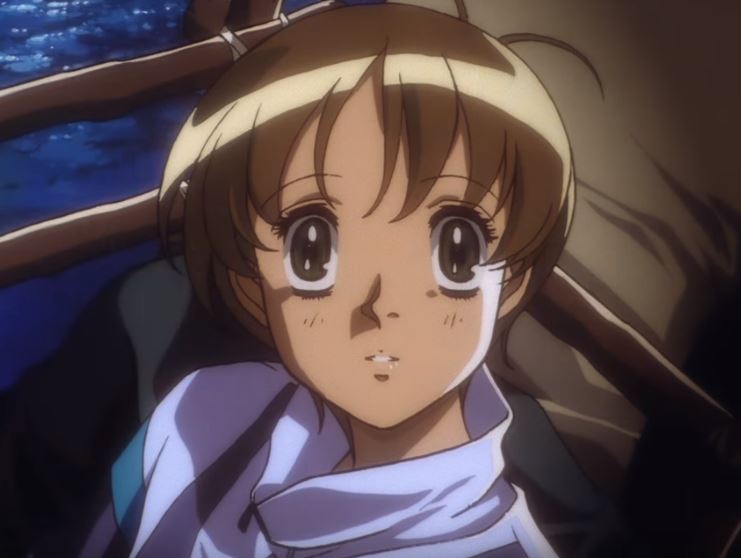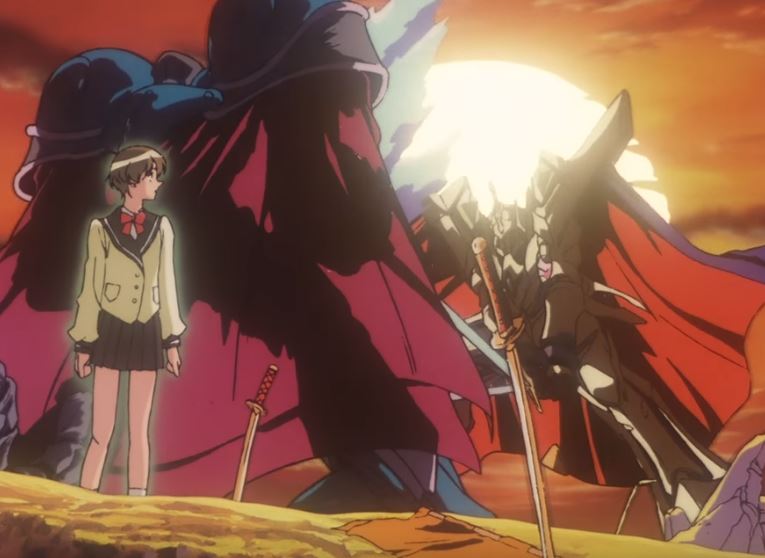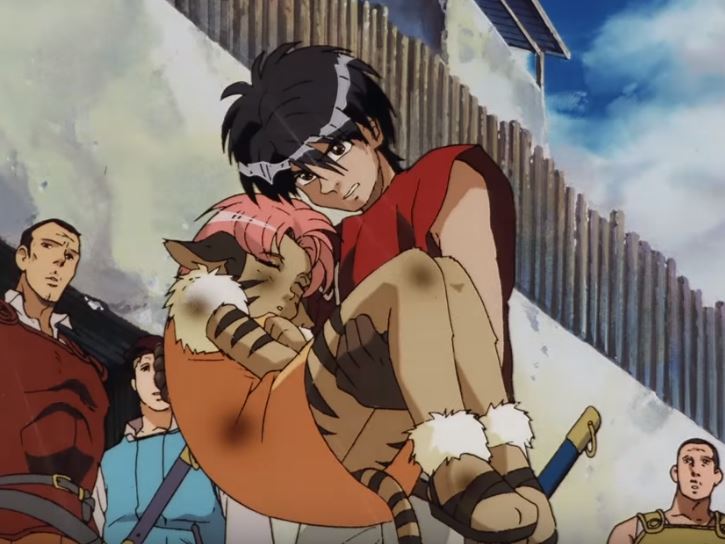Vision of Escaflowne is a fantasy-mecha romance anime. Based off the manga of the same name, the series aired in Japan in 1996. Translated to English in 1998 for VHS release by Bandai, Escaflowne later aired on Fox Kids in 2000. I remember the originally airing on Fox, but it lasted a handful of episodes before being cancelled. YTV, for my fellow Canadians, picked it up the following year and aired it to completion.
Unfortunately, I never experienced the entire series during its initial run. Fox Kids cancelled the series early, and YTV moved it around so much they might as well have cancelled it. Thankfully, there’s been a release with a new translation from Funimation. Streaming Vision of Escaflowne has finally allowed me to complete the series.
The story begins on Earth, with Hitomi and her friends practicing for track & field. Their run is interrupted by the arrival of Van and a fire-breathing dragon. An epic battle ensues in which Van kills the beast and takes its crystal heart. A portal opens in the sky to transport Van home to the world of Gaia, and Hitomi is carried off with him. Gaia is a fairly standard fantasy world where Earth can be seen in the sky. Locals refer to it as the Mystic Moon.
War breaks out between Zaibach Empire and the rest of Gaia, as Empreror Dornkirk seeks the power of Atlantis. Atlantis is of course a lost civilization, once home to a race of winged people, it was destroyed by its own incredible power. This larger plot is a standard fate of the world fantasy narrative. Battles, betrayals and politics are part in parcel. It’s not nearly as complex as Game of Thrones or Fullmetal Alchemist: Brotherhood. What makes Escaflowne standout is its focus on romance.
Van is the angry young prince of Fenalia. Prone to outbursts, he pushes those around him away. It stems from trust issues. His older brother disappeared during a rite of passage, branding him a coward, and leaving Van alone to rule Fenalia as their parents are dead. Early in the series his mentor dies as their captial burns at the hands of the Zaibach Empire. Van’s a difficult character to like, but he’s not annoying. He has enough complexity to his history to explain his actions and personality. He’s not loveable, but you don’t hate him.
Contrasting against Van is the other major male lead, Allan Schazar. A knight of Asturia, Allan is confident in everything he does. He’s a proper soldier. Duty, honor and swordsmanship are important to him, but he’s also caring and selfless. He’s calm and collected, standing out next to Van’s wild anger. Their fights exemplify their differences. Van throws himself at the enemy, often relying on luck and raw passion to succeed. Allan is strategic, making careful decisions to maximize his chance of victory.

The stories romance is primarily focused on Van and Allan, specifically how our protagonist Hitomi feels about them. She spends the series caught between feelings for Van and Allan. She’s a romantic person at heart, but has no experience with how to handle her emotions. Impulsive, she flits between her affection for both men. Thankfully, the story doesn’t turn her into a simple love interest.
Hitomi’s curiosity keeps her engaged in the decisions and mysteries that unfold over the course of the series, and her empathy causes her to struggle with the seemingly endless fighting on Gaia. Throughout the series she pushes back against people who want to control her. Telling her what to do, how to behave and what to think. Hitomi’s rightfully confused and unsure of herself, she’s literally been transported to a world that shouldn’t exist, but adapts and grows in her confidence. She’s a strong lead and absolutely carries the 26 episode series.
Hitomi also carries the burden of representing one of the series main themes, the impact of violence on young people. Death is a constant occurrence on Gaia, and it takes a toll on Hitomi. It’s one of the biggest things she pushes against throughout the story. It’s not easy for her. In fact, Hitomi has a few mental breakdowns instigated by the incredible violence sweeping around her.
The rest of the characters on Gaia accept violence as a fact of life, but for Hitomi it’s a choice they’re making. A choice she abhors and rails against. She rightfully calls out Van and Allan for enjoying fighting, and they are a proxy for the audience. Escaflowne has incredible action scenes to thrill viewers, and we’re called to question our enjoyment of them through Hitomi.

Not only are there plenty of hand-to-hand battles, whether with swords or fists, but this is a mecha-anime. People pilot giant robots that battle with gargantuan swords and weaponized liquid metal spears. Fights are dynamic and exciting, with pulse pounding music accompanying it. Every attack has weight to it, creating tension in each battle. The show has all the hallmarks of a great action series, but it asks the viewer to consider the impact of those scenes.
Violence has real impact beyond immediate physical damage. Injuries take time to recover from. Deaths are remember and impact future choices made by surviving characters. These are broken people struggling to survive. Many shows move passed a character death quickly, using it for a cheap dramatic moment. Escaflowne is a great example of how death should be handled in a narrative.
While it’s not as dramatic a subversion of anime tropes, Vision of Escaflowne does share a similar approach to violence as Neon Genesis Evangelion. Both shows arrived in the 90s after decades of anime popularity in Japan, enough time to generate tropes that new creators actively wanted to avoid. Escaflowne is anything but common with how it handles violence, romance and fantasy narrative expectations. This goes beyond just the main trio of Hitomi, Van and Allan.

Van’s brother, Folken, works for the Zaibach Empire and is responsible for Van’s kingdom being destroyed. Dilandau is a psychotic commander in the Zaibach army, with a massive personality disorder created through forced gender reassignment and ongoing psychological manipulation. Princess Millerna begins as the fairy tale princess, but quickly shows there’s more to her than wide eyed love for Knight Alan Schazar. Merle, a cat girl, is fiercely attached to Van and highly jealous of Hitomi, but throughout the story the two become friends while never losing that jealous edge. Each character proves deeper than their fairy tale trope suggests.
If you’re looking for a fun fantasy adventure or a high octane action series, Vision of Escaflowne is the wrong series for you. Those aspects are presents, but far from the focus. Escaflowne is methodically paced and character driven. At times it’s too slow, letting story elements linger longer than needed. The series runs for 26 episodes, which is probably about 6 episodes too long. The pacing issue is especially clear around the middle of the series. I recommend one or two episodes per day over binge watching to avoid feeling the slump.
Vision of Escaflowne is an excellent anime. It’s not flawless, but it’s definitely worth watching today. At the very least, its beautiful hand drawn animation is worth experiencing, but the characters and their situation will suck you in. Hitomi’s journey across Gaia is currently available on Blu-Ray or streaming on Funimation.

